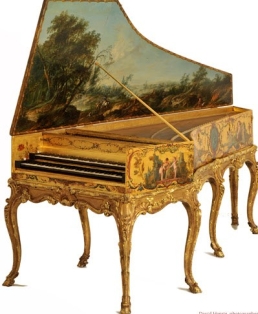Domenica Scarlatti (1685 – 1757) pathed a way for the future school of piano composition. A Neapolitan composer, his harpsichord work was largely composed in Madrid or other Spanish cities. He lived in Spain under the patronage of Queen Mariá Bárbara. He composed more than five hundred of pieces in Spain for the Harpsichord.

He adopted his own creation of dances of the suite. He also self – published thirty works called Essercizi per Gravicembalo (Exercises for Harpsichord, 1738). Each of the movement pieces bears the title of Sonata.
Scarlatti created these Sonatas similar to Chopin, intended to exploit a particular technical configuration. Most editions presented Scarlatti’s Sonatas as an independent piece, nonetheless there are some sources that believed the composer intended Sonatas to be performed in pairs to complement each major and minor tonic tonality.
Although today, Scarlatti’s Sonatas are performed on modern piano, it should be borne in mind that Scarlatti wrote them for the harpsichord. The colouristic effect, choice of harmony, tonalities, and modulations have been well-presented in the different registers of harpsichord.
Sonatas are often based on one theme but occasionally two or three themes. The themes are often simple and clear. Frequently they imbue the spirit of Spanish dance forms, such as the Zapateado or Polo. A large number of his major work have a lively rapid tempo. He also added an additional Spanish flavour into his music using repetition. The single-note repetition represents music for Flamenco singing and dancing.
Scarlatti often uses an Acciaccatura or ‘crush’ note to give an impression of strumming of a guitar. Fughetta style also takes place where a theme is introduced by the right hand and then is imitated by the left.
Due to the tonal drawback of the harpsichord, Scarlatti devised techniques such as hand crossing, echoing back and forth from the extreme reaches of keyboard and the arpeggiated bass figures. He uses a few ornamentations, in particular for Trills. He uses combinations of Appoggiaturas and acciacaturas rendering a less determined sound. His music is invariably elegant in style.
The French Clavecinists
The French Clavecinists (harpsichordist) flourished during the aristocratic salon. French Clavecin schools received influences from the English Virginal schools through French Lutenists. The French lutenists used English types of florid variations. The French Clavecin was not constrained by the technical limitation of the lute but rather adapted the flexible capabilities of their keyboard instrument.


The lute was popular in France even before the beginning of 17th Century. It was used as an accompanying instrument to the air de cour (court air). It gradually gained a solo repertoire through three generations of lutenists. Cira 1680, the lute gave way to the harpsichord. The high point of lute music coincided with the first Clavecin music in France.

The talented Jacques Champion de Chambonniéres who established the technical firmness bore influences upon the compositions of later keyboard composers.
Interestingly, his music was not well received by aristocratic society. The salon audience did not listen ‘long’ and performances were often interrupted by noisy conversation.
The final bar of his compositions usually terminated with a broken chord or a slow arpeggio, which strengthened the force of the cadence. The primary employment of ornaments created an ‘elegant’ style. The second function of the ornaments was to create flowing continuity in both the melodic line and inner parts.
Leave a comment